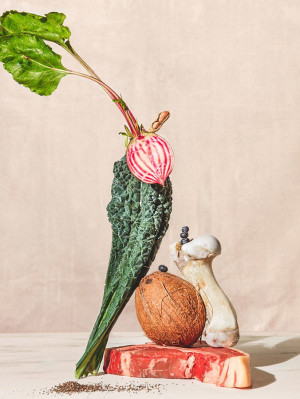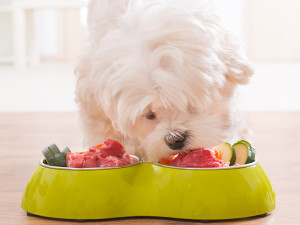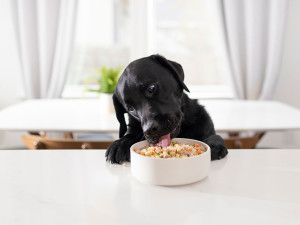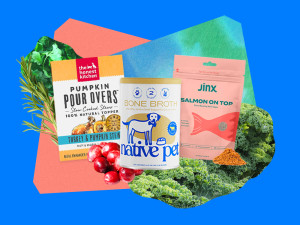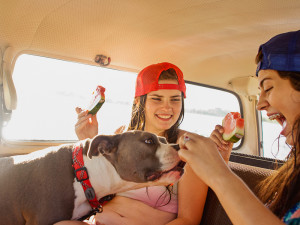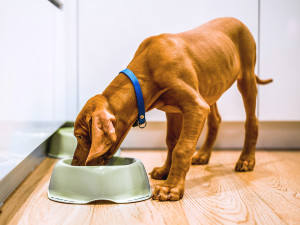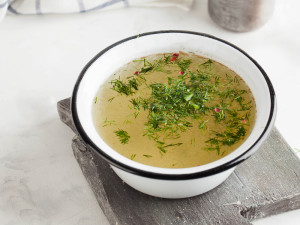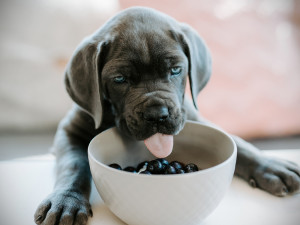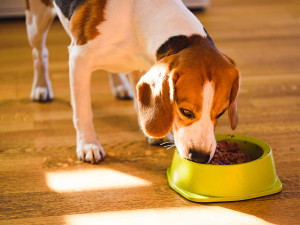Everything You Need to Know About the Raw-Food Diet For Dogs
The feeding practice is popular — should you try it?
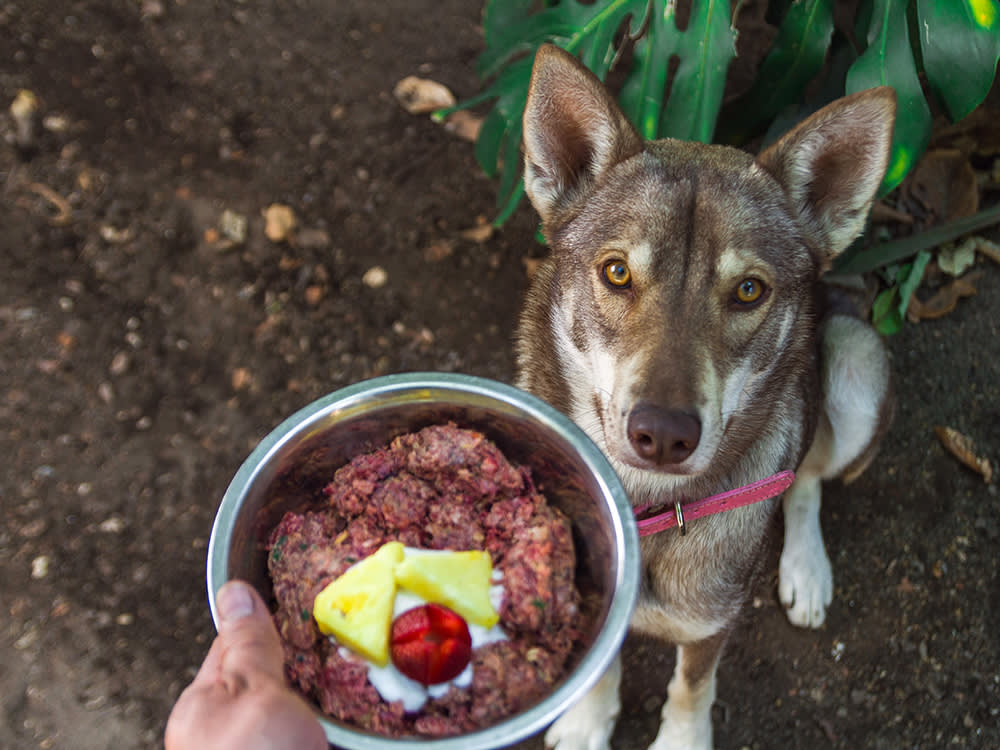
Share Article
The raw-food diet for dogs is having a moment — the feeding practice has gone viral on social media with die-hard fans claiming it leads to cleaner teeth, a shinier coat, more energy, and fewer visits to the vet’s office.
But does science support the raw-food diet for dogs? And what exactly constitutes a healthy raw dog food diet anyway? Here, we explain the somewhat controversial feeding method. Plus, how to try it.
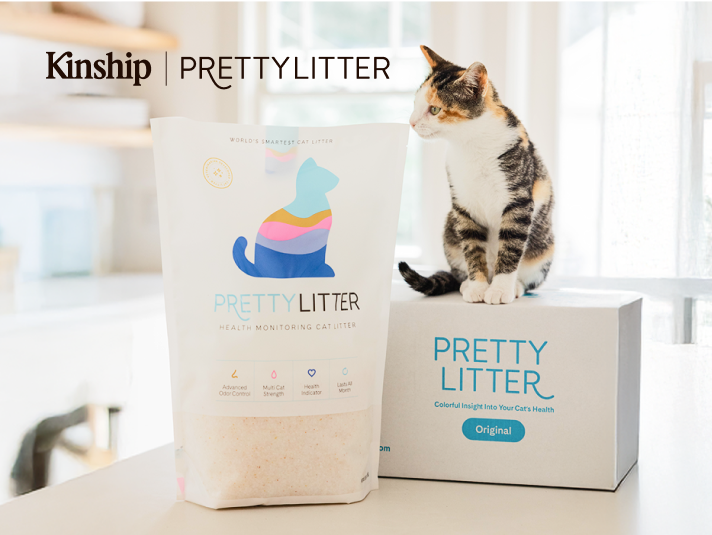
Save on the litter with color-changing tech that helps you better care for your cat.
What is the raw-food diet for dogs?
Raw feeding is exactly what it sounds like: giving your dog completely raw foods, such as fruits, vegetables, and meats. There are two major raw dog feeding techniques. The first, “Biologically Appropriate Raw Food” (which has the unfortunate acronym BARF), was created by veterinary surgeon Ian Billinghurst. It’s made up of 60 to 80 percent raw, meaty bones (such as poultry necks, wings, and backs) and 20 to 40 percent fruits and veggies, meat, eggs, and dairy, along with an abundance of supplements.
The second, the “prey-model” diet, strictly mimics what a dog’s natural diet would be in the wild (think: whole rabbits or game hens). This raw-food diet for dogs recommends 80 percent muscle meat, 10 percent bone, and 10 percent organ meat.
Are there risks involved in feeding a raw-food diet?
All pet foods can contain harmful bacteria, such as salmonella. Like kibble, raw diets undergo checks to ensure they’re safe and germ-free. Store-bought meat, however, can be a little riskier. “Meat sold at the grocery store is allowed to have more bacteria because it’s assumed that it will be cooked before it’s eaten,” says Dr. Judy Jasek, a veterinarian from Animal Healing Artsopens in new tab in Colorado. “If you want to purchase your own meat to feed your [pet], I recommend going to a quality butcher that knows where the meat came from and how it’s been handled.”
Proper sanitation is also important when feeding a raw diet. To keep you and your family members safe, thoroughly wash your hands and all surfaces, utensils, and dishes after feeding raw food. And make sure to follow guidelines opens in new tab for storing raw food.
How to start feeding your dog raw food
Before putting your dog on a raw-food diet, be sure to talk to your vet. Regardless of which approach you choose, the foundational principles are largely the same: Dogs’ meals should be organic, unprocessed, whole food-based and raw whenever possible.
According to most raw feeders, dogs should eat muscle meat (hamburger, chicken, turkey), as well as a healthy array of organ meat (heart, liver, kidneys), whole fish, and raw meaty bones (aka RMBs). Your dog will get calcium and phosphorus from the raw meaty bones, important vitamins and minerals from the organs, and protein from the muscle meat. Cooked bones are dangerous and should never be fed to your dog because cooking leaves the bones brittle and prone to splintering.
To balance out your dog’s nutritional needs, you’ll need to add other ingredients to the menu, including dog-safe vegetables, legumes, some grains, fruit, and supplements. That’s where things can get tricky.
Heidi Hill, the owner of Holistic Houndopens in new tab in Berkeley, California, is a trained homeopath who has been feeding her dog raw food for nearly 10 years. She often advises her customers to start out with prepared diets to avoid becoming overwhelmed or, worse, neglecting the nutritional needs of their dogs.
“If you’re home-cooking or preparing more than, say, 20 percent of your dog’s food yourself, you really need to do your research,” Hill says. Complete-and-balanced store-bought diets and pre-mixes that you can add your own fresh meat to can take the guesswork out of creating a balanced meal for your dog. Hill also recommends that you confirm that products are locally sourced, made in small batches, organic whenever possible, and both hormone and antibiotic-free.
If, on the other hand, you feel up to the task of managing your dog’s nutritional needs yourself, you can work with your veterinarian or an animal nutritionist to ensure that you fill the most common gaps in canine nutrition created by home feeding: bone meal or eggs shells for calcium, fish oil for omega-3s, supplementation for vitamins A and D, and more.
Raw-food diet guidelines to keep in mind
First of all, understand that no one diet fits all dogs. Many dogs, for example, thrive on the fatty acids and minerals in sea vegetables (such as kelp, nori, or dulse), but others may experience allergic reactions to them.
Grains can be a healthy part of your dog’s diet but it’s important to cook them. Go for quick-cooking and economical grains, such as rolled oats (which have the highest protein count per calorie of any common grain), cornmeal, millet, and bulgur.
When it comes to veggies, certain raw ones can be challenging for your dog to digest. Make sure you cook the following: corn, peas, green beans, broccoli, potatoes, and squash. If you have a juicer, mix leftover carrot, beet, apple, or other fruit or vegetable pulp in with the rest of your dog’s meal.
Finally, chia seeds are a great source of antioxidants, protein, fiber, and omega-3 fatty acids for your dog. The most digestible form is a gel, which you can make by whisking one cup of cool water with 1 3/4 tablespoons of seeds. Let it stand for three or four minutes, and whisk again. Wait another 10 minutes, whisk again, and you’re good to go. The rule of thumb for feeding is one tablespoon of gel for every six ounces of food.
How much raw food to feed your dog
Dr. Lew Olson, who has a PhD in natural health and canine nutrition, breaks down the canine diet by weight in her book, Raw & Natural Nutrition for Dogsopens in new tab:
100-pound dog: 2 to 3 pounds daily, or two meals of 1 to 1.5 pounds each
75-pound dog: 1.5 to 2 pounds daily, or two meals of 12 to 18 ounces. each
50-pound dog: 1 to 1.5 pounds daily, or two meals of 8 to 12 ounces each
25-pound dog: 8 to 12 ounces daily, or two meals of 4 to 6 ounces each
In other words, a dog should eat the equivalent of about 15 percent of their body weight each week.
When you’re starting out with raw food, you may want to begin by combining homemade food with high-quality kibble. Remember that not every dog thrives on a raw dog food diet. If your dog is immune-compromised, for example, it might not be the way to go. And while most healthy dogs’ systems can handle many strains of bacteria, good hygiene is still important when handling raw meat. If you’re concerned about your dog choking, grinding meat and bones to a hamburger-like consistency can eliminate the risk.
Be sure to keep your vet in the loop throughout the transition to a raw-food diet. Fans of raw feeding believe that even a partial transition will give your dog such a spring in their step that you’ll be making the switch faster than you can say “RMB.”
Disclaimer alert: This article is here to share information. But, much like pineapple on pizza, the topic may be controversial. Meaning, not all vets or pet professionals agree. Because every pet is a unique weirdo with specific needs. So, don’t take this as fact or medical advice. Talk things over with your vet when making decisions, and use your best judgment (about both your pet’s health and pizza toppings).
Elizabeth Kennedy
Elizabeth Kennedy is a freelance writer and editor in the San Francisco Bay Area.
Related articles
![Teenagers Feeding a Dog Watermelon While Sitting In Car On a Sunny Day]()
9 Healthy Summer Snacks to Share With Your Dog
Your pup wants in on your crudité platter.
![brown puppy eating food out of green bowl]()
A Digestible Guide to Healthy Dog Food for Your New Pup
How to pick the right grub for your dog when there are So. Many. Choices.
![Bone broth soup]()
Let Your Dog Lap Up Your Bone Broth
It isn’t just a healthy cocktail for the likes of Gwyneth Paltrow and Kylie Jenner. And we’ve got a recipe.
![Puppy eating a bowl of blueberries]()
10 Superfoods You Should Share With Your New Dog
From kale to quinoa, these nutrient-packed picks deserve a spot in your dog’s food bowl.
![a black dog eats from a white bowl]()
8 Best Fresh Food Delivery Services For Dogs
Feeding your dog healthy whole foods is easier than ever.
![Beagle eating food out of a dog bowl]()
Supplements Are Going to the Dogs
An integrative vet helps suss out what’s beneficial versus what’s bogus.
